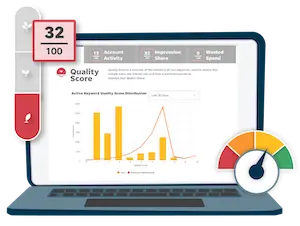Conversion tracking is a very important part of seeing success in Google Ads. Fortunately, and unfortunately, conversion tracking options have gotten more complex over the last few years. That means while you have lots of options to customize your conversion tracking, you also have many opportunities to make mistakes that could cause your campaign tracking to be accurate.
In this article, I’m going to walk you through how you can organize the conversion tracking settings in Google Ads to make sure that you’re counting all the conversions that you want to optimize for while also seeing insights into other key actions for your campaigns without having false performance indicators.
How to customize Google Ads conversion tracking
Follow these steps to customize Google Ads conversion tracking so you can better understand how your campaigns are performing.
- Understand Google’s conversion tracking structure
- Set up primary conversions
- Organize conversions into categories
- Check or update your account default goals
- Choose your campaign-level conversion goals
- Follow conversion set up best practices
The first thing I want to do is talk about the organization of the Summary page in the Conversion Manager. As you can see in the screenshot above, there are different organization levels, depending on which portion of the conversion tab you’re looking at. There are three boxes with labels of Submit lead form, Sign-up, and Phone call lead. Each of these boxes is called a conversion category. Those I have outlined in an orange box.
![]()
Categories house the individual conversion actions. I have these outlined in green in the Submit lead form category. Conversion action must be aligned with conversion categories to help organize your conversion tracking.
![]()
Each time you create a new conversion action, you get to select which category you want the new conversion to be aligned with. Always choose the one that best aligns with your overall categories, but don’t worry if you decide to change things up later. Conversion categories can be reassigned for existing conversion actions.
Now that we have the general structure out of the way, let’s start talking about the nitty-gritty details of what you can do on the conversion manager page to ensure your campaigns are optimizing for the goals you want.
🛑 Worried you’re wasting spend in Google Ads? Find out with a free, instant audit >> Google Ads Performance Grader
The first detail I want to cover is for each conversion action, and it determines whether a conversion action will actually be counted in the Conversions column or not. Now that might sound a little confusing, but don’t forget, there’s an All Conversions column as well. This is where Primary vs. Secondary conversion actions come into play.
In the screenshot below, you can see that all three conversion actions we have in the Submit lead form category are Primary conversions. That means their conversions will be tracked in the Conversion column.
![]()
If I were to click on the first conversion action and then click Edit settings…
![]()
I could then open the Action Optimization dropdown and adjust this conversion action to be a Secondary action. The blue box on this page tells us why that’s important.
![]()
Conversion actions that are set to Secondary are not used in the Conversions column and will not be optimized for. That means anything labeled as a Secondary conversion action will not impact bidding strategies that are trying to improve conversions. Target CPA, Max Conversions, Target ROAS, and Maximize Conversion Value are all bidding strategies that work to drive as strong of performance as possible for the conversions that are prioritized.
Here’s the point to take away: Only include conversion actions as Primary Conversions that you want to count in the Conversion column and that you want automated bidding to optimize for. These should be your lead form submissions, phone calls, content downloads, etc. Too many accounts I audit have regular landing page or time on site goals as Primary conversions when they should be Secondary to these other goals. If those are the only actions you have to work with, then okay. But if you have anything beyond a page view, I would highly suggest you make sure you’re only including the main goals as Primary actions. (Here are some more conversion tracking mistakes to avoid!)
While it might not seem like a big deal and there are some workarounds, I find it’s much easier to manage my Google Ads accounts when my conversion categories actually make sense. We’ll discuss why later, but for now, this is my PSA.
Here are the conversion categories Google has by default:
- Purchase
- Add to Cart
- Begin Checkout
- Subscribe
- Contact
- Submit Lead Form
- Book Appointment
- Sign-Up
- Request Quote
- Get Directions
- Outbound Click
- Page View
- Other
There are a ton to work with, and keeping your conversion actions in clean categories can be really useful when setting up campaigns.
![]()
If you don’t see a category that fits, you can create a Custom Goal that allows you to basically name your own category for whatever makes sense.
![]()
Just remember, conversion actions can only go in one conversion category. For example, if I click on the three gray dots next to our main conversion action, I can then Change to another conversion goal, then I have to select which category I want to move it to. The organization itself just needs to make sense to you because of the section we’re going to talk about next.
⚡️ Is your Google Ads account set up for success? Download now >> The Last Guide to Google Ads Account Structure You’ll Ever Need
You may have noticed the little gray text next to the conversion category name in the image above: Account-default goal.
![]()
If I hover over that text, we see that default goals are used for all campaign optimization. There’s a caveat coming for this later, but for now, let’s assume this is accurate.
This means that every new campaign you create in Google will automatically count all Primary conversion actions in your Account Default Goal categories as conversions.
So for this account, that means the three goals in the Submit Lead Form, the All Thank You Pages in Sign Up, and Call Clicks from Ads in Phone Call Lead will all be included in the Conversion column and optimized for in that campaign.
![]()
If you want to change which goals are account defaults, all you have to do is click the Edit Goal button on the far right, then you can choose the option to not use that category as an account goal. Easy peasy.
You’ll also see from this page you can easily change a conversion action’s optimization from Primary to Secondary or vice versa without the more detailed steps I mentioned above.
In the image below, you’ll see the Submit Lead Form category is only applied to 62 of 63 campaigns. How is that so if it’s an Account Default Goal?
![]()
This is the caveat I mentioned above and has to do with campaign-level conversion optimization.
For any campaign, you can navigate to the settings tab, then open up the Conversion goals section and in the first drop-down, you can select either Account Default or Campaign Specific. From there, you can adjust the conversion categories you use for that individual campaign.
![]()
Once you’ve changed to Campaign Specific, you can choose the Change conversion goals link.
![]()
From there, you simply check the boxes next to the conversion categories you want to use for that campaign.
![]()
It’s at this stage that I find it very helpful to have clear conversion categories. Since you’re not able to see what conversion actions make up each category, it’s so much easier to have things organized in such a way that makes logical sense so you can easily opt into the categories and actions you want and not have to go back and forth from the conversion manager to keep things straight.
Once you’ve made the changes you need, you can save the settings and your campaign will now be optimizing for only those new conversion actions.
📚 Free guide >> 12 Secrets to a Higher Click-Through Rate (& Lower Costs!)
Now that you know how the conversion organization process works, I thought it might be helpful to outline my suggested best practices to make sure you have your account set up for success.
- Make sure all conversion action tracking is accurate.
- Organize all conversion actions into clear and common-sense groupings.
- Make sure only the goals you want to optimize for are set as Primary actions. All others should be secondary.
- Align Account Default Goals with your overall strategy with Google Ads.
- Leverage Campaign Level Goals when a campaign deviates from the overall strategy or needs to leverage goals that shouldn’t be tracked for other campaigns.
Set up your Google Ads conversion tracking the right way
There’s a lot of power and customization available in Google Ads conversion tracking, but it can also be a bit overwhelming and easy to make mistakes if you’re not sure what you’re doing. Hopefully, this article helps to clarify what controls do what and gives you a road map for how you should set up your conversion tracking in your account for better promotional ads. Need help? Schedule a demo to see what we can do for you.









Comments
Please read our Comment Policy before commenting.